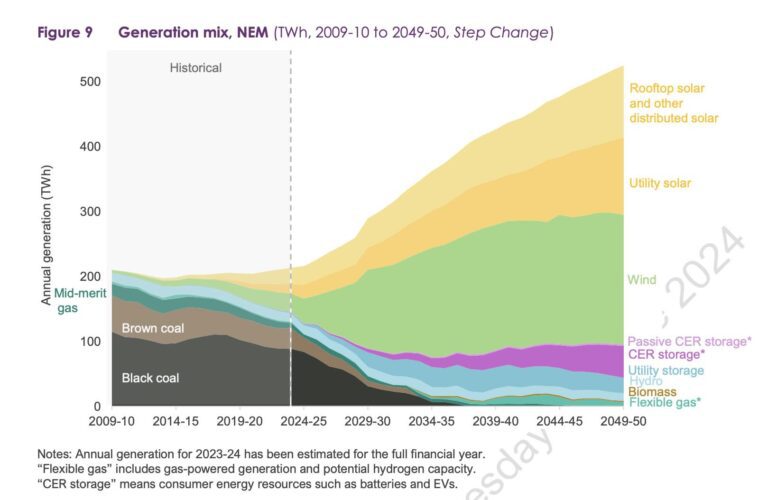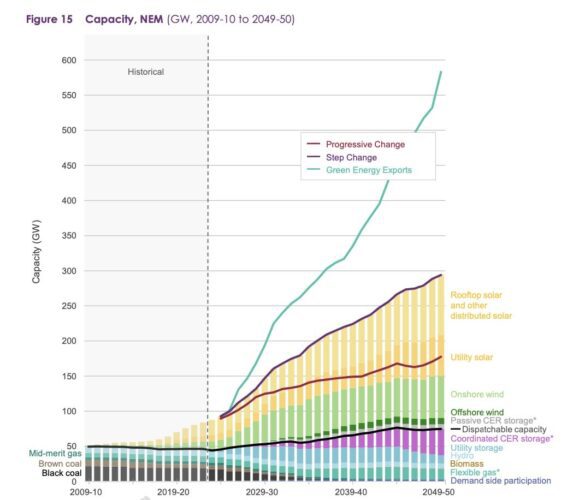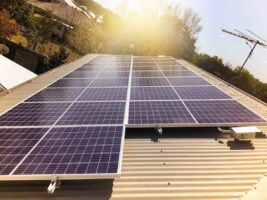The Australian Energy Market Operator has confirmed that a combination of renewables and storage, backed by significant investments in transmission upgrades, remains the cheapest and smartest course for Australia to replace its ageing coal plants and slash emissions in its electricity grid.
The final version of its latest 25-year planning blueprint, the 2024 Integrated System Plan, says Australia can and should reach 82 per cent renewables by 2030, laying the groundwork for all coal fired power generators to leave the grid by 2038.
It maintains that the cost of large-scale renewable generation, storage and transmission between now and 2050 will be around $122 billion, and while it does not consider nuclear as an option – because it is not legal in Australia – it says that nuclear would be too slow and, according to the GenCost report it co-authors with the CSIRO, way too expensive.
“The ISP is a roadmap to navigate Australia’s power system through the energy transition, providing Australians with reliable electricity at the lowest cost,” said AEMO chief executive Daniel Westerman. “Australia’s energy transition is well underway, with renewable energy accounting for 40% of electricity used in the past year.”
Most of the details of the final ISP are little changed from the draft released in December – apart from the fast-tracking of some transmission projects, noting a big increase in battery storage projects, and dialing in a price on emissions – but the document has become a focus of federal Coalition and conservative attacks against both AEMO and the CSIRO, the country’s two key institutions.
In effect, these have become attacks against the energy industry itself. Westerman points out that the ISP is produced after consultation, analysis and review involving 2,100 stakeholders, 85 presentations and reports, and the consideration of 220 formal submissions.
The federal Coalition however, insists that they are all wrong – the whole industry – and that wind, solar and storage cannot be relied upon to power a modern economy; that nuclear power is needed to replace coal.
At the same time, it wants the rollout of large-scale wind and solar stopped, coal-fired power stations kept open as long as they can, and the gap until multiple nuclear power plants are built, potentially by the mid 2040s – filled with gas.
The energy industry is unanimous in pointing out how crazy that plan is, in terms of cost, emissions, and reliability. And the ISP underlines the sheer scale of what needs to be built in the next two decades to replace and cope with a big increase in demand, driven by economic growth, green industries and electrification of homes, businesses and cars.
AEMO says that to reach the 2030 renewable target, an average of 6 gigawatts of new wind and solar needs to be added each year to provide the bulk energy, and then another 4 GW on average every year after that out to 2040.

This graph above is the generation mix forecast out to 2050 in the “step change” scenario that remains the central scenario in the ISP modelling. i.e. it is the one voted most likely by the experts it has consulted.
By 2050, demand has more than doubled – to more than 500 terawatt hours just on the country’s main grid.
More than 90 per cent of the generation is provided by solar – both rooftop and large scale – and wind, supported mostly by battery storage, hydro and some flexible gas, which is likely to include green hydrogen power plants, such as the one due to come into service in South Australia in early 2026.
It is important to note that while gas capacity increases – from around 11 GW now to 15 GW – it is for rarely used “peaking plants” and the share of gas in terms of generation for the grid falls significantly.
Consumer energy resources (CER) are also expected to play a key role. Chief among these is rooftop solar – tipped to quadruple from 21 GW now to around 86 GW in 2050, and household batteries, which AEMO says could save $4.1 billion in avoided costs in grid investment – if they are “well co-ordinated.”

Indeed, households will also play a critical role in the take up of electric cars, and smart systems to help “orchestrate” these consumer resources. AEMO promises more work on how CER can be further developed, perhaps reducing the investment needed in large scale projects.
“Consumers are already a driving force in Australia’s energy transition and this is set to continue. If consumer devices like solar panels, batteries and electric vehicles are enabled to actively participate in the energy system, then this will result in lower costs for all consumers,” Westerman said.
The final version of the ISP includes the fast-tracking of seven transmission projects that are now deemed “actionable” by AEMO, but not all include new poles and wires. They include several smaller upgrades, some smaller and less complex solutions, and some which are open to non-network solutions.

AEMO says the step change scenario requires around 5,000 km of new transmission lines to be built over the next decade – not the 28,000 km often cited by the Coalition – and half of this is already under construction. The total requirement for step change out to 2050 is for less than 10,000 km.
AEMO says that the total cost of the that transmission build and upgrade for the step change scenario will be around $16 billion, but insists that this will deliver more than $18 billion of benefits – largely from lower costs from the transport of electricity from one part of the country to the other. Another $3.3 billion in benefits come from emission reductions.
Westerman acknowledged the challenges and risks to delivering the transition on schedule, including delays in approval processes, investment uncertainties, cost pressures, social licence issues, supply chain disruptions and workforce shortages. He did not mention connection problems, which might be cited by many in the industry.
“There is a real risk that replacement generation, storage and transmission may not be available in time when coal plants retire, and this risk must be avoided,” Westerman said.
“This ISP is a clear call to investors, industry and governments for the urgent delivery of generation, storage and transmission to ensure Australian consumers continue to have access to reliable electricity at the lowest cost.”
Federal energy and climate minister Chris Bowen, says the overwhelming market response to the first auction under the Capacity Investment Scheme – which is seeking 6 GW of new wind and solar capacity and was nearly seven times oversubscribed – will accelerate the rollout of renewables to the pace required.
“There is a huge investment pipeline in renewables, and our policies are bringing that pipeline forward,” Bowen said in a statement. “The ISP shows the transformation is well underway.
He also used the ISP to take another swipe at the federal Coalition.
“AEMO tested 1000 scenarios to identify the lowest-cost plan that would also meet our growing electricity needs and keep the grid reliable between now and 2050,” Bowen said in a statement.
“Their findings are in stark contrast to the Coalition’s anti-renewables nuclear planwhich will see Australians pay hundreds of billions for the reactors alone, would provide at best 4 per cent of Australia’s energy needs by 2050, and could add $,1000 a year to energy bills.
“Peter Dutton and David Littleproud don’t have the guts to tell Australian’s the details of how they plan to keep the lights on and keep electricity bills down for households and businesses, because it simply won’t stack up when compared to what the energy industry experts are telling us today.”
Analysts, energy experts and industry groups generally applauded the new ISP, with some noted the scale down transmission projects that were fast-tracked, and others the growing recognition of the power of consumer energy resources.
“The 2024 Integrated System Plan confirms what we already know – that the optimal, lowest cost pathway to deliver net zero by 2050 is to dramatically accelerate the development of more renewables combined with energy storage and transmission,” Clean Energy Council chief executive Kane Thornton said in a statement.
But others suggested Australia’s transition needs, and could, go even faster. ClimateWorks says the “step change” scenario in the ISP is consistent only with capping global warming at 2°C, and scientists insist that the 1.5°C should be the target.
“The 2024 Integrated System Plan confirms what we already know – that the optimal, lowest cost pathway to deliver net zero by 2050 is to dramatically accelerate the development of more renewables combined with energy storage and transmission.

Anna Malos, the Australian lead for ClimateWorks and a former assistant director at the Climate Change Authority, said AEMO’s Green Export Scenario, which does align with the 1.5°C scenario, should underpin each ISP from now on.
She notes that, dispute the concern about the potential delays in meeting the the “step change” scenario, a focus on rapid decarbonisation at region centres such as the iron ore province in the Pilbara, and the soon to be former coal regions in the Hunter could drive rapid change.
Some companies, she noted, particularly those who were clear about the opportunities of future green business models, were already embracing this change.
“The Australian Industry Energy Transitions Initiative, co-convened by Climateworks, found that just five industrial regions account for one-eighth of Australia’s total emissions – equivalent to the emissions of every car and light commercial vehicle across the country,” she said.
“Getting renewable energy to the right places – through additional ISPs specifically for these regions – could have an enormous impact on the nation’s emissions reductions.”







